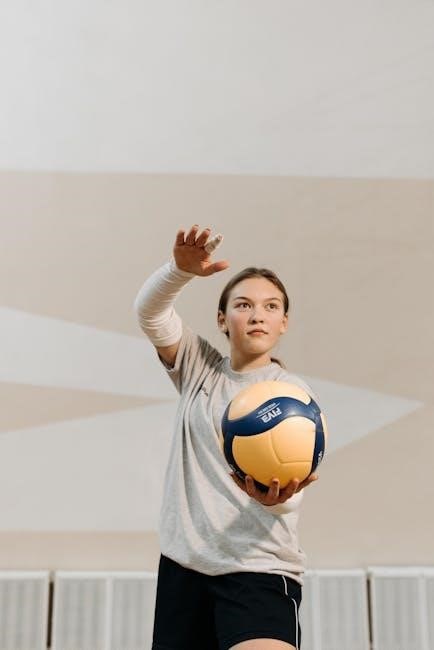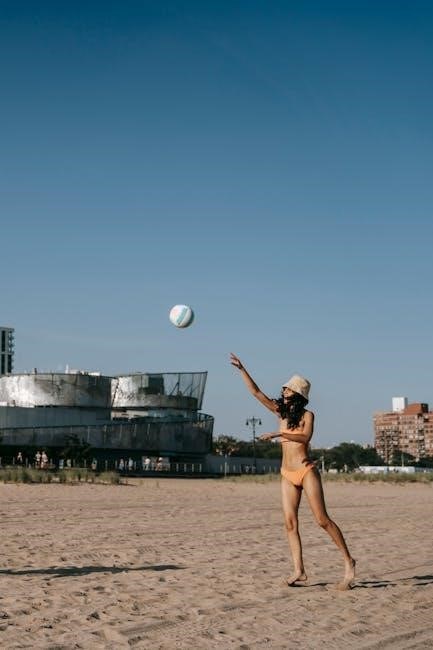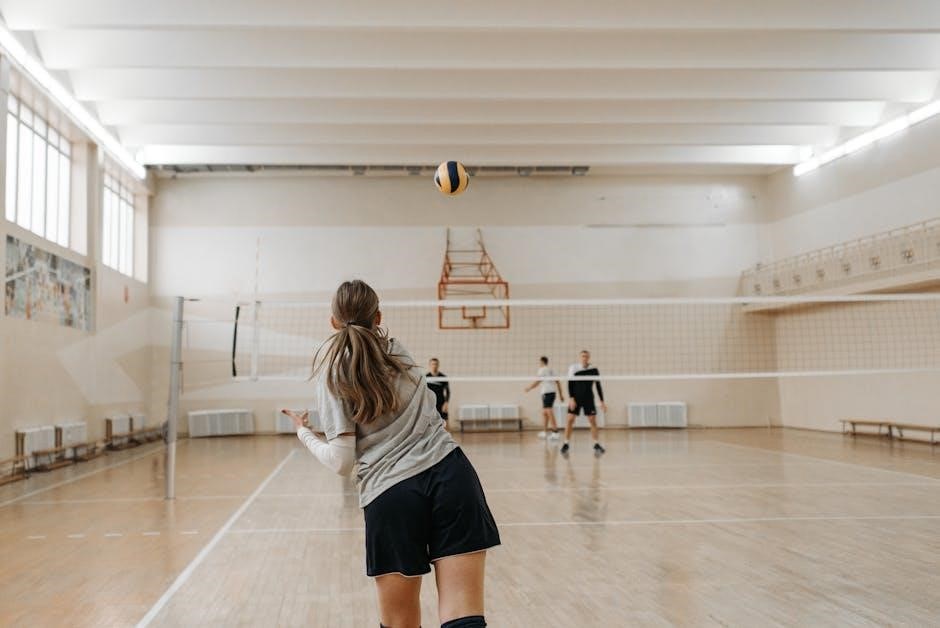
Volleyball rules are essential for ensuring fair play and consistency across all levels of the sport. The FIVB governs global standards, providing official guidelines for indoor, beach, and snow volleyball. Understanding these rules enhances gameplay and player safety, making it a vital resource for athletes, referees, and fans. This article explores key aspects of volleyball rules, including recent updates and their impact on the game.
1.1 Overview of Volleyball as a Sport
Volleyball is a dynamic team sport played globally, requiring skill, strategy, and physical fitness. It involves two teams of six players each, aiming to score by landing the ball on the opponent’s court. The sport is popular in both indoor and beach formats, emphasizing teamwork and quick reflexes. Volleyball combines strength, agility, and tactical play, making it accessible and exciting for players and spectators at all levels.
- Played indoors or on sand surfaces.
- Requires coordination and communication among teammates.
- Combines offensive and defensive strategies.
1.2 Importance of Understanding the Rules
Understanding volleyball rules is crucial for fair play, player safety, and consistent gameplay. The FIVB governs the sport with standardized regulations, ensuring clarity for players, referees, and spectators. Adhering to rules promotes sportsmanship, reduces conflicts, and enhances overall enjoyment. Familiarity with rules helps athletes avoid penalties and referees enforce decisions accurately, maintaining the integrity and flow of the game at all levels.
- Ensures fair competition and sportsmanship.
- Prevents injuries by enforcing safe play standards.
- Helps referees make consistent decisions.
Game Characteristics
Volleyball is a dynamic team sport requiring skill, strategy, and physical fitness. It involves hitting a ball over a net, blending speed and precision for success.
- Played by two teams of six players each.
- Objective is to hit the ball over the net.
- Combines strength, agility, and teamwork.
2.1 Objective of the Game
The primary objective in volleyball is to hit the ball over the net and make it land on the opponent’s side of the court. Teams aim to prevent the ball from touching their side while attempting to make it land on the opponent’s side. This is achieved through a combination of attacks, blocks, and defensive plays. The Rally Point System, where a point is scored on every rally, adds intensity to the game, emphasizing precise teamwork and skill.
- Hit the ball over the net into the opponent’s court.
- Prevent the ball from touching the ground on your side.
- Score points through effective teamwork and strategy.
2.2 Duration and Structure of the Match
A volleyball match is typically played as a best-of-five sets, with each set won by reaching 25 points first. The match duration varies based on performance, averaging 60-90 minutes. Teams alternate serves, and timeouts are limited to two per set. The Rally Point System ensures continuous play, emphasizing strategic breaks. This structure ensures balanced competition and maintains engagement throughout the game.
- Best-of-five sets, each to 25 points.
- Match duration: 60-90 minutes.
- Two timeouts per set.
- Rally Point System for continuous play.
Player and Team Rules
Volleyball teams consist of six players on the court, with substitutions allowed under specific regulations. The Libero, a defensive specialist, has restricted movements and must follow substitution rules.
3.1 Number of Players and Substitutions
A volleyball match is played by two teams, each consisting of six players on the court. Teams are allowed up to six substitutes, with no limit on substitutions per player. The Libero, a defensive specialist, can only enter through the back row and must follow specific substitution protocols. Substitutions are made through the designated zone to maintain fair play and ensure smooth gameplay continuity. Beach volleyball differs, with smaller teams and simplified substitution rules.
3.2 Roles of Players (including Libero)
In volleyball, each player has a distinct role. The Setter coordinates attacks, while Outside Hitters and Opposite Hitters score points. Middle Blockers focus on blocking and quick attacks. The Libero, a defensive specialist, wears a different jersey and is restricted to the back row. They cannot block or attack but excel in defensive actions. Recent rule updates allow the Libero to be team captain, enhancing their leadership role. Substitutions for the Libero must follow specific protocols to maintain fair play.

Scoring System
Volleyball uses the Rally Point System, where a point is scored on each rally. A match is won by reaching 25 points with a two-point lead. The fifth set caps at 15 points, ensuring competitive fairness. This system streamlines scoring, emphasizing precision and strategy.
4.1 Rally Point System
The Rally Point System awards a point to the winning team of each rally, regardless of which team served. This system replaces the traditional side-out scoring, ensuring continuous play. Matches are typically best-of-five sets, with the first four sets played to 25 points and the fifth set to 15 points. A two-point advantage is required to win any set. This format enhances excitement and fair competition, as every rally directly impacts the score. Consistent with FIVB regulations, the system promotes fast-paced and strategic gameplay, ensuring clarity and engagement for players and spectators alike.
4.2 Special Scoring Situations
Special scoring situations in volleyball include let serves and replaying points. A let is called if the ball touches the net but still lands in the opponent’s court, resulting in a replay. If the serving team wins the rally, they score a point and retain serve. If they lose, the opposing team gains a point and the right to serve. These rules ensure fairness and maintain the flow of the game, adhering to FIVB guidelines for consistent scoring practices across all matches.
Violations and Faults
In volleyball, common violations include lifting, carrying, or touching the net. These faults result in a point for the opposing team, ensuring fair play and adherence to rules.
5.1 Common Violations (Lifting, Carrying, etc.)
Common violations in volleyball include lifting or carrying the ball, where the ball is held or tossed. These actions are illegal, as the ball must be hit, not caught. Players may also commit faults like touching the net or crossing the center line. Double contacts, where a player contacts the ball twice in a row, are also violations. These infractions result in points for the opposing team, ensuring fair play and maintaining game integrity.
5.2 Consequences of Violations
Violations in volleyball result in points being awarded to the opposing team. If a player or team repeatedly breaks the rules, they may receive warnings or penalties. Severe or intentional fouls can lead to loss of service or even a side-out. These consequences ensure fair play and maintain the integrity of the game, while also promoting sportsmanship among players and teams.
Officials and Their Roles
Officials ensure fair play and enforce rules during matches. The referee makes final decisions, while assistant referees assist with calls and scorers track game statistics.
6.1 Referee and Their Responsibilities
The referee is the primary authority during a volleyball match, ensuring adherence to rules and maintaining fair play. They enforce regulations, manage game flow, and make final decisions on disputes. The referee supervises the entire match, interprets rules, and handles appeals from players or coaches. Their responsibilities include overseeing substitutions, monitoring timeouts, and ensuring player safety. In beach volleyball, the referee also manages court conditions and coordinates with other officials to maintain smooth gameplay.
6.2 Role of Assistant Referees and Scorers
Assistant referees and scorers play crucial roles in supporting the referee and ensuring accurate game management. Assistant referees monitor specific areas like service, net play, and substitutions, while scorers maintain detailed records of points, fouls, and timeouts. Their collaboration ensures smooth gameplay, accurate scoring, and adherence to rules. These officials work together to provide a fair and organized match environment, supporting the referee’s decisions and overall game flow effectively.

Equipment and Court Setup
Volleyball equipment and court setup must adhere to FIVB standards. The indoor court measures 18×9 meters, with a net height of 2.43m for men and 2.24m for women. The ball weighs 260-300g, with a circumference of 65-67cm, ensuring fair play and safety.
7.1 Dimensions of the Volleyball Court
The volleyball court measures 18 meters in length and 9 meters in width for indoor play. The free zone extends 5 meters from the sidelines and 6.5 meters from the end lines. The free playing space above the court must be at least 7 meters high to ensure safe play. These dimensions are standardized by the FIVB for consistency across all official competitions, ensuring fair and regulated gameplay.
7.2 Net and Antennae Specifications
The volleyball net stands at 2.43 meters for men and 2.24 meters for women, measured from the center to the floor. Antennae, 1.8 meters long and 10 mm thick, are placed at the net’s extremities, aligned with the top. The net must be securely fastened to the poles, with edges reinforced by a 5 cm wide band. These specifications ensure safe and consistent gameplay, adhering to FIVB standards for official competitions.

Differences Between Indoor and Beach Volleyball
Indoor and beach volleyball differ in court size, team composition, and rules. Indoor features six players per side on a larger court, while beach volleyball has two players, smaller courts, and no libero. Scoring systems and substitution rules also vary, adapting to the unique demands of each environment.
8.1 Key Rule Variations
Indoor and beach volleyball have distinct rule variations. Indoor courts are larger, with six players per team, while beach volleyball is played on smaller courts with two to four players. Substitutions are limited in beach volleyball, and scoring systems differ slightly. Equipment specifications, such as net height and ball size, also vary. The libero position is exclusive to indoor volleyball, adding unique strategic elements. These variations adapt the game to its environment and player numbers.
8.2 Unique Aspects of Each Version
Indoor volleyball features a libero position, offering defensive specialization, while beach volleyball emphasizes dynamic plays with fewer players. Indoor courts require standardized lighting, ensuring visibility, whereas beach volleyball adapts to natural conditions. These variations enhance the sport’s adaptability, catering to different environments and player preferences, while maintaining core principles that define volleyball’s global appeal and competitive spirit.

Special Rules and Positions
The libero position is unique to indoor volleyball, with specific restrictions on attacking and blocking. Substitutions are limited and must follow strict rotational rules for fairness.
9.1 Libero Player Regulations
The libero is a defensive specialist who cannot block or attack the ball in front of the attack line. They must wear a contrasting uniform color and are limited to back-row substitutions. The libero can only enter the game through the back border and cannot serve in most competitions. Recent rule updates allow the libero to be the team captain, enhancing their leadership role while maintaining their unique positional restrictions.
9.2 Substitution Procedures
Substitutions in volleyball must follow specific rules to maintain gameplay integrity. Teams are allowed up to six substitutions per set, with players entering and exiting through the substitution zone. The libero can replace any back-row player but must follow proper rotation procedures. Illegal substitutions, such as entering the court without permission, result in penalties. Recent updates clarify substitution protocols to ensure fair play and maintain the flow of the game.
Recent Rule Changes
The 2021-2024 FIVB rules introduced key updates, including the libero being eligible as team captain and modifications to substitution zones. These changes aim to enhance gameplay fairness and efficiency.
10.1 Updates in the 2021-2024 FIVB Rules
The 2021-2024 FIVB rules introduced several updates to enhance gameplay and fairness. Key changes included allowing the libero to serve and act as team captain, modifying substitution procedures, and clarifying rules on lighting standards for competitions. These updates aim to improve player safety, streamline match processes, and ensure consistency across all levels of play, reflecting the evolving nature of the sport.
10.2 Impact of Rule Changes on Gameplay
The 2021-2024 FIVB rule changes have significantly impacted gameplay by enhancing player roles and streamlining procedures. The libero’s expanded responsibilities, including serving and captaining, have added strategic depth. Modified substitution rules reduce delays, maintaining game flow. Clarified lighting standards ensure better visibility and safety. These updates promote a more dynamic, fair, and spectator-friendly experience while keeping the sport adaptable to modern demands and player needs.
Volleyball Signals and Hand Gestures
FIVB hand signals clearly communicate referee decisions, ensuring clarity and consistency. Official charts detail each gesture, aiding players, coaches, and spectators in understanding calls effectively during matches.
11.1 Official Hand Signals for Referees
Official hand signals are standardized by the FIVB to ensure clarity in refereeing decisions. Signals include gestures for fouls, substitutions, and gameplay pauses. Referees use precise movements to indicate actions like lifts, carries, or net touches. These signals are universally recognized, ensuring consistency across all matches. Proper execution aids players, coaches, and spectators in understanding rulings instantly, maintaining game flow and fairness. Familiarity with these signals enhances overall game comprehension and adherence to rules.
11.2 Common Signals for Players
Players use hand signals to communicate strategies and plays during matches. Common signals include indicating the type of play, such as a set or block, and defensive positioning. These signals are often universal, ensuring clarity between teammates. Clear communication enhances teamwork and minimizes errors. Understanding these signals is crucial for players to execute plays effectively and maintain coordination during the game, fostering better collaboration and performance on the court.
Volleyball rules ensure fair play and consistency, governing all game aspects. Adhering to these rules enhances the sport’s integrity and enjoyment for players and spectators worldwide.
12.1 Summary of Key Rules
Volleyball rules govern gameplay, ensuring fairness and consistency. Teams consist of six players, with the objective of grounding the ball on the opponent’s side. The rally point system awards points to the winning team of each rally. Common violations include lifting, carrying, and touching the net. The libero role is unique, focusing on defense. Recent rule updates, such as the libero being team captain, enhance gameplay dynamics. Adherence to these rules ensures a balanced and enjoyable sport for all participants.
12.2 Importance of Rule Adherence
Adhering to volleyball rules ensures fair play, sportsmanship, and safety for all participants. Consistent rule enforcement maintains the integrity of the game, allowing players to compete on a level playing field. Understanding and respecting the rules fosters a culture of respect among athletes, referees, and fans. Proper rule adherence also prevents injuries and disputes, ensuring a balanced and enjoyable experience for everyone involved in the sport.